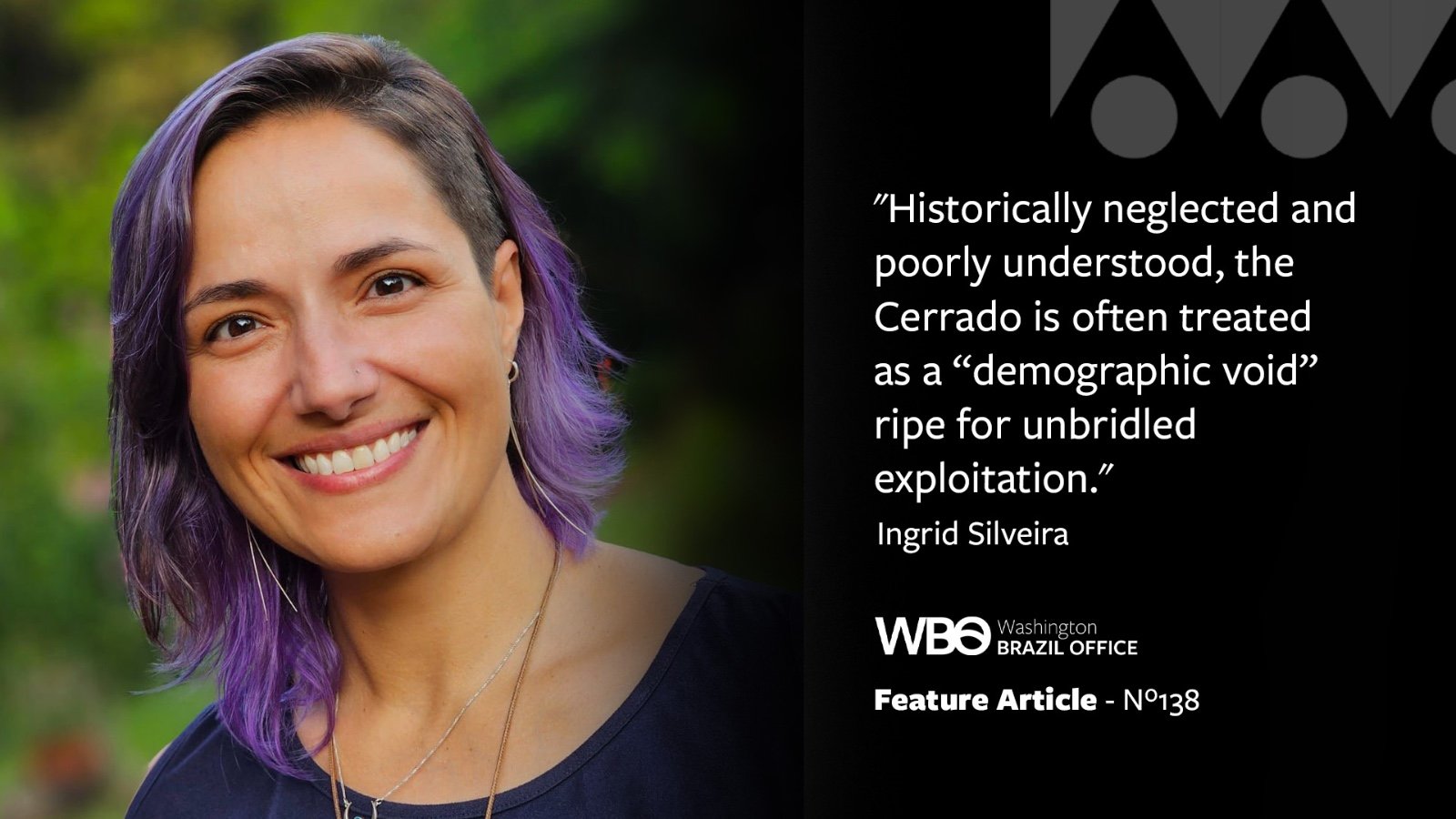Cerrado: The Invisible Biome, Heart of the Waters and Guardian of Life
Ingrid Silveira is executive secretary of the Cerrado Network. This article was written for the 138th edition of the WBO weekly bulletin, dated October 11, 2024. To subscribe to the bulletin, simply enter your email in the form.
The Cerrado emerged 80 million years ago, making it one of the oldest biomes on the planet. In just fifty years, predatory human action has destroyed 50% of the native vegetation of this biome, which is the second largest biodiversity reserve in Brazil and the most biodiverse savannah on the planet – a biome that has about 5% of all species in the world.
So much damage in such a short time! The harmful impacts of human action were aggravated in 2024 by the more than 60,000 fires recorded, many of them arson, which for days covered the skies of several Brazilian cities with smoke. Most of these fires occurred in the region known as Matopiba (the initials of the states of Maranhão, Tocantins, Piauí and Bahia), a critical area of agricultural expansion. Fires in the Cerrado contribute to land conflicts and land grabbing, mainly by facilitating illegal deforestation and the expansion of agribusiness. The use of fire quickly destroys large areas of native vegetation, allowing these lands to be converted into pastures and monocultures, such as soy and cattle. This illegal practice favors the undue appropriation of land, often through the invasion of Indigenous territories, traditional communities, and protected areas, which intensifies land conflicts. In addition, fires force local communities to leave, increasing the vulnerability of these areas to land grabbing.
These fires not only emit large amounts of CO₂, contributing to global warming, but also directly affect biodiversity, causing habitat loss and animal deaths, in addition to damaging soil quality and the rainfall cycle. And here we have a point of great concern: water resources.
The Cerrado occupies a strategic position in the center of the continent, in the Brazilian Central Plateau, spilling water over the whole of Brazil and part of South America, supplying eight of the twelve main Brazilian river basins. Because it directly supplies the Amazon, the Pantanal, the Atlantic Forest and the Caatinga, ensuring the survival of millions of people, flora and fauna, this biome is known as the “heart of the waters”. Historically neglected and poorly understood, the Cerrado is often treated as a “demographic void” ripe for unbridled exploitation. For it to be truly understood, it is essential to recognize its unique characteristics. In a beautiful dynamic, the “flying rivers” bring humidity from the Amazon to the Cerrado, forming a water cycle of interdependence. This occurs because the Cerrado has a differentiated vegetation: it is an “inverted forest,” where most of the biomass is in the deep roots, which are up to 15 meters deep. These roots have an essential function: to transport and store water, creating true underground rivers that feed aquifers and surface rivers. Without the vegetation of the Cerrado, these bodies of water would be depleted, leading to the collapse of the chain ecosystems and impacting not only Brazil, but all of South America.
In addition to its fundamental ecological function, the Cerrado is home to an impressive diversity of peoples, cultures, and ways of life. These peoples, who include Indigenous communities, quilombola communities made up of descendants of escaped enslaved people, geraizeiros (traditional inhabitants of the Cerrado from northern Minas Gerais), babassu coconut breakers, wild plant gatherers, among other important traditional groups, have an intimate and sacred relationship with the land. For these communities, the Cerrado is not just a natural resource to be exploited, but a living entity, an extension of their own existence. They see the land as a mother who feeds and cares for them and, in return, they practice sustainable management methods that preserve and enrich the biome. The cultural diversity and ancestral wisdom of these peoples are invaluable. They have resisted for centuries, maintaining agricultural and extractive practices that promote the conservation of the Cerrado, while ensuring their own subsistence. This harmonious relationship with the environment is a living example that the coexistence of human development and environmental conservation is not only possible, but necessary.
The protection of the Cerrado is closely linked to the protection of its peoples, whose survival is fundamental to the preservation of the biome. The path to reversing its degradation involves recognizing the rights of Traditional Peoples and Communities, who act as its true guardians. It is essential that the international community, including socio-environmental organizations and the United Nations, support sustainable development policies that respect and value these ways of life. Furthermore, the goal of zero deforestation – both legal and illegal – must be non-negotiable, while the promotion of agroecological practices and the restoration of degraded areas are crucial to ensuring that the Cerrado continues to play its vital role as a climate regulator and water supplier.
Considering this scenario, it is imperative that the world wake up to the reality of the Cerrado. It is not just a Brazilian biome, but a heritage of humanity, whose preservation is essential for global climate stability and for the water security of the South American continent. The Cerrado is the heart of the waters, and without water there is no life.


